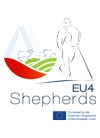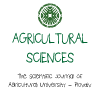Animal Nutrition and Technology of the Fodders
|
Course title: |
Animal Nutrition and Technology of the Fodders | |
|
ECTS: |
5 |
|
|
In-class hours |
Lectures: |
30 |
|
Laboratory work/Tutorials: |
30 |
|
|
Self-preparation hours |
Practical training: |
15 |
|
Other: |
50 |
|
|
Total hours: |
125 |
|
|
Language: |
English |
|
|
Study cycle: |
Bachelor |
|
|
Semester: |
Winter |
|
|
Faculty: |
Faculty of Agronomy |
|
|
Name of the lecturer(s): |
Prof. Dimo Penkov, PhD, Dr.Sci. |
|
|
Mode of delivery: |
Face-to-face |
|
|
Prerequisites: |
Physiology and Biochemistry of the domestic animals, Forage Crop Production, Working with Excel |
|
|
Learning outcomes of the course unit: |
Object of this course is the study of: 1.Main nutritional and biologically active substances in the feeding of domestic animals. Methods of differentiation. Essential Nutrient Requirements of Animals. 2. Energy nutritional value of feed for different animals. 3. Protein nutritional value of feed for different animals. 4. Animal requirements for energy intake and specific nutrients - feeding norms. 5.Nutritional values of the forages, methods for forage production and conservation, principles of their feeding, and management 6.Composition of rations and combined foods for different species and categories of domestic animals.
Learning Outcomes: The students will be knowledgeable in: 1.The concept of essential nutrients in animal nutrition is the provision of the necessary energy and protein through food. 2. Energy values and protein requirements of animals and methods of their calculation. 3.Preparing and conservation of different forages (silages, hay, energy and protein fodders, wastes from the food- and beverly (хранително – вкусова) industry, methods for treating of fodders, before feeding, principles of preparing of combined fodders. 4.Practical feeding of the domestic animals – preparing of rations, composition of combined fodders, nutritional regime for the different animal species. The students will utilize the acquired knowledge in their further education for: - Calculation of animal requirements for energy and essential nutrients. - Management of the forages and the forage producing; - Balancing the feeding ratios of different domestic and avian species according to their physiological and productive characteristics. |
|
|
Course contents: |
Lectures – 30 hours
1.Chemical composition of the plant and animal products. Weende - methods. Water and mineral substances and their role in animal nutrition. Crude protein. Nitrogen – content fractions. Amino acids. Required nitrogen fractions for different animals and birds.Crude fats (ether extract) – chemical composition, importance in feeding. Fatty acids. Carbo -hydrates. Crude fiber. Non Protein extract. Required quantities of fats and carbo - hydrates for different animals and birds. Van Soest – analysis. Neutral detergent fiber (NDF). Acid detergent fiber (ADF), modified ADF. Chemicellulose, cellulose, lignine. Acid detergent protein. Vitamins. Vitamins A, D, E, K (definitions, classifications, functions, deficiencies, etc.). B-Vitamins, (definitions, classifications, functions, deficiencies, etc.) – 2 hours 2. Types of energy and their distribution in the body. Ways of calculation. Energy units for feeding different types and categories of animals - ruminants, horses, pigs, birds, rabbits. Calculation formulas. – 2 hours 3. Protein nutritional value of forages. Systems for its determination in ruminants and non-ruminants. Calculation formulas. - 2 hours 4. Animal requirements for energy and basic nutrients according to species, category and productivity. Requirements for individual functions of the body and types and amounts of productivity. Summary norms. Basic calculation formulas. – 2 hours 5. Forages and forage additives. Classification of the forages. Grass forages. Intensive grass – species. Meadows and pastures – maintenance, using, management. Feed quantities for the different animals. Hay – preparing. Ascendenting factors on water evaporation – hay quality. Hay deposition, using for feeding of different animals, nutritive values, requirements of feeding. Artificial dehydrated fodders. Low energy wastes – fodders- methods for increasing their energy nutrition values. Silages. Conditions and silage – techniques. Raw stuffs for silages. Kinds of silages. Quantity estimation. – 2 hours 6. Energy fodders - cereals. Protein fodders. Treatments before feeding. Wastes fodder – from the flour-mills, sugar – extraction industry, winery, brewing, food and beverly industry. Nutritive values, methods of feeding. Waste from vegetable oil-producing. Fodders with animal origin, bacteria origin, synthetic fodders., forage feeds, Nutritive values and methods of feeding. – 2 hours 7. Forage additives. Non protein N- compound. Synthetic amino - acids. Mineral and vitamins – additives. Probiotics. Antioxidants, emulsifiers, enzymes. Combined fodders. Raw materials for combined fodders. Classification. Technological processes. Quality control. Regulation of the trading – 2 hours. 8. Cattle – feeding. Feed formulation. Rations formulation. Practical feeding of dairy cattle. Management of the feeding. Feeding of young breeding beefs and cattle. Practical feeding of meat – cattle breeds. Fattening of beefs. Feeding of different categories buffalos. – 4 hours 9. Practical feeding of sheep and goats- pregnant, milking, young animals for breeding and fattening. – 3 hours 10. Feeding of different categories of horses. Fodders and fodder consumption. – 1 hour 11. Feeding of different categories of swine (reproductive and for fattening). Nutrient requirements. Fodders and fodder consumption. - 2 hours 12. Feeding of different categories of hen. Combined fodders for them – preparing and practical feeding. Feeding for egg – production for consumption and incubation. Feeding of young breeders. Fattening of broilers. Feeding of different categories of turkeys.- 4 hours 14. Feeding of ducks. Feeding of guinea-fowls, Japanese quails. Feeding of different categories rabbits (cuniculas) – 2 hours
Practical exercises - 26 hours 1.Calculation of energy nutritional value of feed for different animals - net energy for ruminants (FUM, FUG), digestible energy for pigs, metabolizable energy for birds – 2 hours 2.Calculation of the requirements for different activities of dairy cattle – DM intake, Energy (FUM), protein (PDI), Ca, P, Vit A, NaCl. Calculating of summary requirements – 1 hour 3.Calculation of the requirements for different activities of young beets and cattle (breeding and fattening) – DM intake, Energy (FUG), protein (PDI), Ca, P, Vit A, NaCl. Calculating of summary requirements – 1 hour 4.Calculation of the requirements for different activities of different categories sheep, Energy (FUM, FUG), protein (PDI), Ca, P, Vit A, NaCl. Calculating of summary requirements – 1 hour 5.Calculation of the requirements for different activities of different categories swine – reproductive and for fattening, Energy (DE), protein (CP), Ca, P, Vit A, NaCl. Calculating of summary requirements - 1 hour 6.Calculation of the requirements for different activities of hen – layers and broilers, Energy (ME), protein (CP), Ca, P, Vit A, NaCl. Calculating of summary requirements - 1 hour 7.Composition of rations for dairy cows and pregnant non – milking cows. – 2 hours 8. Composition of rations for young cattle for breeding and fattening – 2 hours 6. Composition of rations for different categories sheep and goats. – 2 hours 9. Principles for fodder balance – composition. Formulation of individual projects – 2 hours 10. Composition of rations for different categories of horses. – 2 hours 11. Composition and balancing of combined fodders for different categories of swine – 2 hours 12. Composition and balancing of combined fodders for different categories avian – egg laying hen, young chicken for breeding and fattening – 3 hours 13. Composition and balancing of combined fodders for different categories avian- turkeys, ducks - 1 hour. 14. Composition and balancing of combined fodders for different categories rabbits (cunicula) – 2 hours
Seminars 15. Fodder balance in farms (for ruminants) – 2 hours 16. Continuation of 14 (for swine and poultry) – 2 hours
|
|
|
Recommended or required reading: |
1.Nutrition of the Animals, N. Tododrov, A. Ilchev, V. Georgieva, D. Girginov, D. Djuvinov, D. Penkov, Z. Shindarska, 2004, Con-Car - Sofia (311pp, BG) 2.Ensminger, M. E. J. Oldfield, W. Heinemann, 1990, Feeds and Nutrition, Ensminger Ed., LA, 1240pp 3. Pond, W., D. Church, K. Pond, P. Schoknecht, 2005, Basic animal Nutrition and Feeding, 5-th Ed., John Wiley and Sons – Pub.House, ISBN 0-471-21539-2 4. Kellems, R., D. Church, 2010, Livestock Feed and Feeding, 6-th Ed., Pearson AG – Ed., ISBN (print) 978-0-13-159475-3 5. ARC, 1981, The nutrient requirements of pigs, Commonwealth Agricultural Bureaux, Farnham Royal, England 6.ARC, 1984, The nutrient requirements of ruminant livestock, Supplement 1, Commonwealth Agricultural Bureaux, Farnham Royal, England 7.NRC, 1994, Nutrient requirements of poultry, 9-th rev. Ed., NAP, Washington 8.NRC, 1989, Nutrient requirements of dairy cattle, 6-th rev. ed. NAP, Washington, DC 9.NRC, 1999, Nutrient requirements of domestic animals, Nutrient requirements of swine, Wash. DC |
|
|
Planned learning activities and teaching methods: |
Monological explanation (lecture, presentation, briefing, tutorials), Dialogue methods (conversation, discussion, brainstorming) Independent work under the guidance of a specialist - working with programs to determine the requirements of animals and drawing up rations/recipes for combined feed in Excel environment. |
|
|
Assessment methods and criteria: |
Forms of self – training (non- auditoria’s work)
III. 4.1. EDUCATIONAL PRAXIS- 15 hours The praxis will be hold in the fields of teaching-experimental base – the students take part by the preparing of hay, feeding of the animals and birds ect. III. 4.2. Individual project- 35 hours for preparation The students become their individual projects after exercise 6. Volume of the presentation – 5-8 pages (mostly tables and figures) – 5-10 minutes presentation during the seminars (with discussion). Format of the individual assignment:
Prepare forage balance in a farm with ….. dairy cows (with the young cattle for breeding (fattening), ….. sheep (goats), : The dairy cattle are with live weight …… kg, daily milk yield….. l, protein/fat in the milk……%. The daily growth of the young cattle is: breeding animals… kg, animals for fattening- …. kg, the final live – weight for the fattened animals is……. kg ………………………………………………………………………………………………….. 1. Calculate the requirements of 1 animal for 24 hours 2. Formulate basic rations for all categories in the farm (for summer and winter springtime, fall….) 3. Calculate the quantities of needed fodders – for different seasons and for the whole year. 4. ……………………………………..
III. 4.3. SELF - TRAINING FOR THE TESTSDURING THE SEMESTER AND THE EXAMINATIONS - 30 hours I. POLICIES All students are required to be present during all lectures. No credit will be given without participating in class! Two auditoriums and a research base in the Department of Animal Sciences will be used for practical trainings. The students will work on an individual basis under the supervision of the academic advisor so that the best possible learning outcomes are ensured. The seminars consist of each student’s individual 5 – 10 min presentation and a discussion. The presentation topics will be given in advance. After each practical exercise the students become individual task (composition ration, combined fodder etc.). At the end of the semester a practical exam will be holt. The final grade will consist of the practical final exam – 25%, the individual project – 25%, and final theory exam – 50%. If the student receives a grade of 2 in any of the first two components of the final grade, the student will not be allowed to the final theory exam and will fail the class. The final theory exam is in written form. Grades are determined based on a six point marking system 6 = A 4 = C 5 = B 3 = D |
|
 - Events on the occasion of the 80th anniversary of AU
- Events on the occasion of the 80th anniversary of AU











